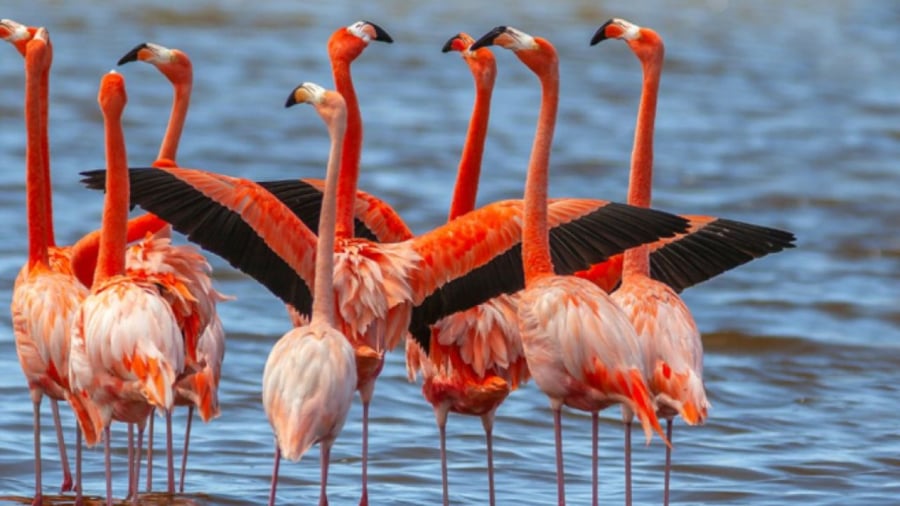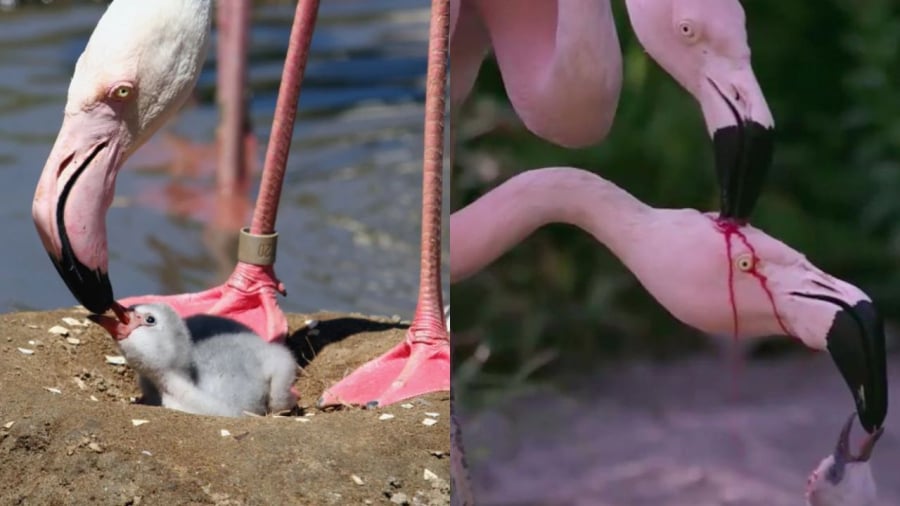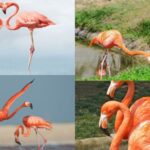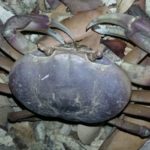The bird earned the name flamingo from its distinctive pink plumage. This is one of the world’s unique and captivating bird species, renowned for its long legs, bright pink or crimson feathers, and iconic behaviors and characteristics that symbolize love, loyalty, and family.
Origin and Habitat of Flamingos
Flamingos have graced the Earth for approximately 40 million years, primarily inhabiting wetlands and saline lakes in Africa, South America, Central America, and the Indian subcontinent. They live in flocks and are typically found in shallow waters, where their natural food sources are abundant.
These birds are characterized by their long legs, graceful curved necks, and unique beaks—with the lower part larger than the upper and curved downwards. This beak structure enables flamingos to feed by filtering water, efficiently sucking and straining algae, shrimp, and small insects.

Do Flamingos Feed Their Young with Their Blood?
One of the most intriguing aspects of flamingos is the vibrant pink to crimson color of their feathers, leading some to believe that they dye their plumage.
Folk tales and legends speak of flamingos feeding their young with their blood or brain matter, thus dyeing the chicks’ feathers red. Shocking videos circulated online appear to show adult flamingos “piercing each other’s heads” to feed their chicks blood.
However, this is a misunderstanding. In reality, the red liquid consumed by the chicks is crop milk, a specialized form of milk produced by glands in the digestive system of both male and female flamingos. Crop milk is rich in proteins and fats and contains carotenoids—natural pigments found in plants and animals, responsible for the red or pink coloration of the feathers. This milk flows from the adult bird’s beak into the chick’s mouth, without any piercing or bloodshed as rumored.
Unraveling the Mystery of Pink Feathers
The pink coloration of flamingos’ feathers is not innate. Flamingo chicks are born with grayish-white plumage, and it takes about three years for their bodies to accumulate sufficient carotenoids from their diet for the feathers to gradually turn pink. Flamingos primarily feed on shrimp, algae, insects, and mollusks, all of which are rich in carotenoids. These pigments, once absorbed, remain in their feathers, skin, and even eyes, creating their distinctive coloration.
The shade of pink can vary from pale pink to deep crimson, depending on their diet and environment.

Unique Behaviors and Fascinating Lifestyle
Flamingos are not only aesthetically pleasing but also renowned for their unique behaviors. Notably, when foraging for food, they often turn their heads upside down in the water and use their beaks to filter out small organisms—a mechanism rarely seen in other bird species.
Additionally, flamingos are capable of standing on one leg for extended periods, reducing heat loss through their legs—an intelligent adaptation to their cold or hot aquatic environment.
Symbol of Love and Fidelity
Flamingos are monogamous birds that form long-lasting pair bonds. During courtship, they perform group dances, head flagging, wing stretching, and produce characteristic sounds to attract potential mates.
Once paired, the couple builds a conical mud nest approximately 30 cm high to protect their egg from flooding. The female lays a single egg each season, and both parents take turns incubating it for 28–32 days until it hatches.
After hatching, the chick relies solely on crop milk for the first two months of its life before it can start foraging for food independently.
Flamingos: An Endangered Species
Despite their worldwide admiration, flamingos face significant threats. The decline of wetlands, environmental pollution, climate change, and illegal hunting have all contributed to their dwindling numbers.
Conservation organizations have advocated for enhanced protection measures and the restoration of their natural habitats in wetlands and saline lakes.
Flamingos embody not just the epitome of grace and fidelity but also the epitome of nature’s sophistication. From their stance to their coloration and parenting techniques, flamingos exhibit wondrous survival and adaptation strategies. Accurate understanding and appreciation of these unique birds foster a sense of responsibility for conserving biodiversity and preserving the planet’s vibrant life.



































